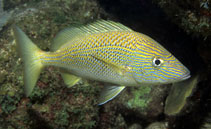| Family: |
Haemulidae (Grunts), subfamily: Haemulinae |
| Max. size: |
53 cm TL (male/unsexed); max.weight: 4,380.0 g |
| Environment: |
reef-associated; marine; depth range 3 - 40 m |
| Distribution: |
Western Atlantic: Chesapeake Bay, through the Gulf of Mexico and Caribbean southward to Brazil. Including Antilles (Ref. 26938). |
| Diagnosis: |
Dorsal spines (total): 12-12; Dorsal soft rays (total): 17-17; Anal spines: 3-3; Anal soft rays: 9-9. Side of head has narrow blue stripes; scales above lateral line much larger than those below (Ref. 26938). Scale rows just below lateral line oblique; color variable but usually light yellowish (Ref. 13442). |
| Biology: |
Found in dense aggregations during the day on patch reefs, around coral formations, or on sandy bottoms (Ref. 9710). Juveniles common in Thalassia testudinum beds (Ref. 5217). Feeds on crustaceans, small mollusks, and small fishes. Frequently exhibits a territorial 'kissing' display in which two contenders push each other on the lips with their mouths wide open (Ref. 9710). Marketed fresh. Has been reared in captivity (Ref. 35420). |
| IUCN Red List Status: |
Least Concern (LC); Date assessed: 10 October 2015 Ref. (130435)
|
| Threat to humans: |
reports of ciguatera poisoning |
Source and more info: www.fishbase.org. For personal, classroom, and other internal use only. Not for publication.

